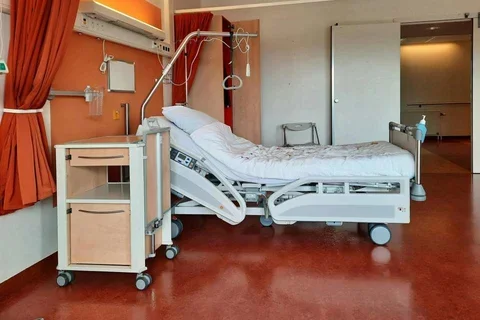The U.S. could experience a critical hospital bed shortage by 2032, new research warns
Driven mainly by a reduction in staffed beds, the U.S. hospital occupancy is on trend to reach 85% in the next 7 years

Hospital admission wait times following an unplanned emergency room visit are expected to get longer.
In a new UCLA study published in JAMA Network Open, a team of UCLA researchers predict that post-pandemic hospital occupancy rates will increase rapidly, leading to even longer delays in receiving a hospital bed.
Prior to the start of the Covid-19 pandemic, U.S. hospital occupancy hovered at 63.9%. Following the end of the pandemic, U.S. hospitals saw a 11-point increase to 75%, driven primarily by a 16% percent reduction in the number of staffed hospital beds.
Without immediate action, the U.S. occupancy for beds could reach 85% by 2032, signaling a national bed shortage. Richard Leuchter, MD, assistant professor-in-residence in the department of medicine in the David Geffen School of Medicine (DGSOM) at UCLA, and lead investigator on the study, notes that this 10-point increase could have a direct impact on health outcomes. “If the U.S. were to sustain a national hospital occupancy of 85% or greater,” said Leuchter, “it is likely that we would see tens to hundreds of thousands of excess American deaths each year.”
From a financial perspective, inpatient hospital care represents over half of all wasteful spending and contributes to 75% of medical debt (which is responsible for 65% of U.S. bankruptcies).
A commentary accompanying the study called for increasing hospital capacity to avoid “increasingly overloaded hospitals” incapable of delivering high-quality, accessible care. At the same time, however, the commentary by Drs. Alexander Janke and Arjun Venkatesh noted that a surge in new hospital beds could also raise the risk of low-value care.
In an effort to mitigate the risks of a national bed shortage, wasteful spending and low-value care, Dr. Leuchter and team, in collaboration with UCLA Healthcare Value Analytics and Solutions (UVAS), part of the UCLA Clinical and Translational Science Institute (CTSI) Integrating Special Populations (ISP) Program Hub, have developed the Next Day Clinic, an innovative healthcare delivery solution that aims to reduce patient admissions by proving timely acute outpatient care.
Catherine Sarkisian, MD, MSHS, senior author of the study and UVAS leader, as well as Dr. Leuchter’s primary mentor for his K38 award from the National Heart, Lung, and Blood Institute (NHLBI), said, “Dr. Leuchter and I have a longstanding interest in reducing low- value care, for example hospitalizations that are avoidable. With its focus on reducing low-value care, the UVAS infrastructure support is a perfect match with this line of work.”
The Next Day Clinic (NDC) was pioneered within the nation’s second largest public safety net health system at Olive View-UCLA Medical Center, a Los Angeles County Department of Health Services-affiliated hospital located in the San Fernando Valley.
The NDC offers a wide array of services such as imaging/laboratory studies typically only available in hospitals to divert patients who are traditionally admitted from the ED to the outpatient setting, and to allow for already hospitalized patients to be discharged several days sooner than they traditionally are. In addition to medical care, the NDC offers intensive outpatient case management and care coordination to provide personalized care navigation and address social drivers of hospitalization (e.g., transportation insecurity can be addressed by funding ride shares), all with the goal of reducing ED visits and admission.
In less than one year, the Olive View Next Day Clinic saved over five hundred hospital bed-days and $1.09 million, receiving an award for “Top Oral Presentation” at the Society of Hospital Medicine national meeting in April 2025.
The Clinic is now being launched at UCLA Ronald Regan Medical Center where Leuchter and his team are testing its impact on hospital overcrowding in a randomized clinical trial.
In addition to support from the ISP Program, the research team also received support from the UCLA CTSI Biostatistics, Epidemiology and Research Design (BERD) Program. BERD’s Sitaram (Ram) Vangala serves as a co-investigator, providing statistical expertise for the research study.
The research study, supported, in part, by Leuchter’s K38 Career Development Award, also received a grant studio consultation from the Special Populations program prior to submission.
Speaking on behalf of the research team, Dr. Sarkisian, who is also a professor at DGSOM, staff physician at the Greater Los Angeles VA Health System, and program leader of the CTSI ISP Program, stated: “We feel very fortunate to work at DGSOM with UCLA Health where we have such strong leaders who value collaborations between medical school researchers and health system innovators. CTSI support has been invaluable facilitating this collaboration and getting us closer to our shared vision of being a true Learning Health System.”
---------
For more information on the study, read the recent press release in the UCLA Health Newsroom. The research has also been featured in ABC7 News, which provides additional insights into the looming hospital bed shortage and its risks for patients.
Image source: Pexels